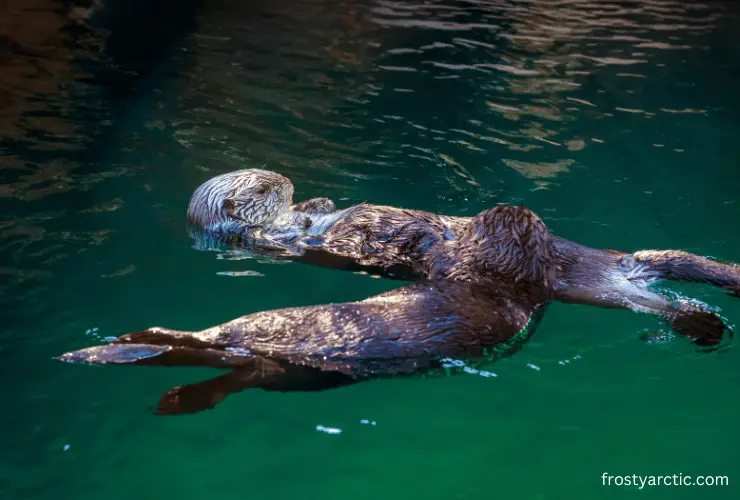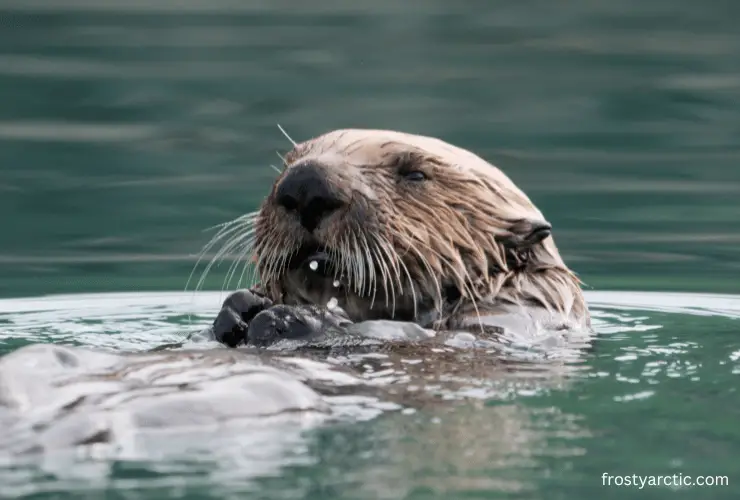Sea otters are highly intelligent animals. They have large brains and complex nervous systems that allow them to learn, remember, and solve problems. Impressively, they are among the few mammals, other than primates, that can use tools without any training or prior experience.
Ever seen a sea otter crack open a shell using a rock as a hammer? That’s their intelligence shining through! Their unique behaviors and survival strategies have undoubtedly intrigued scientists and animal lovers alike, prompting a wealth of research into their cognitive capabilities.
But what makes sea otters so smart?
If a sea otter’s antics have ever left you in awe and made you ponder the brains behind those sparkly eyes, you’re in for a fun ride. Come with us as we dive deep into the world of sea otter intelligence. You’ll be surprised at how amazingly they show off their brain power.
Are Sea Otters Smart and Intelligent?
Sea otters are indeed smart and intelligent. When we consider intelligence in animals, it often involves various factors, including problem-solving abilities, use of tools, brain size, and long-term memory.

Let’s break down these facts to understand the intellectual prowess of these fur-bearing mammals.
● Problem-Solving Abilities: An Indicator of Intelligence
Problem-solving is a fundamental indicator of intelligence across species. Sea otters excel in this domain.
For example, in some regions where their habitats are regularly exposed to strong currents or waves, these marine mammals are known to anchor themselves to kelp or seaweed to prevent being washed away while they rest or eat.
This anchoring behavior indicates their ability to strategize and adapt to their environment to ensure their safety and well-being.
Did you know sea otters can also solve puzzles? The otter uses its paws and sharp mind to twist, turn, and manipulate the puzzle until it successfully opens it.
● Sea Otters and Tools They Use: A Sign of Intelligence
In the animal kingdom, tool use is considered a sign of higher cognitive functioning. According to a research article published at CORE, sea otters are among the few marine animals known to use tools, which points to their intelligence.
For example, sea otters don’t give up easily when faced with a clam or a mussel encased in a tough shell. They have learned to use rocks as an anvil, hammering the shell until it breaks open to reveal the nutritious meal.
Between 2007 and 2017, a team of researchers dedicated a decade to studying the eating habits of sea otters at Bennett Slough Culverts’ location in California. They found that the sea otters at this site most frequently ate mussels.
Interestingly, these were the only creatures the sea otters cracked open using stationary anvil stones. In fact, approximately one-fifth of the mussels consumed by these sea otters involved using such stones. ~ Source
A study published in Biology Letters demonstrated that sea otters also use rocks to dislodge prey from crevices. This indicates these marine mammals can flexibly adapt their tool use according to the situation, a clear sign of their cognitive capabilities.
Did you know? The sea otters even prefer certain rocks, keeping a favorite ‘tool’ stored in a pouch of skin under their arm for later use.
These otters are adept at manipulating objects with their forepaws, which have retractable claws and tough pads for gripping. They can rub, twist, pull, or tear objects with great strength and skill.
● Sea Otters’ Brain Size and Structure
Scientists often consider the brain-to-body mass ratio a preliminary measure of intelligence across various species. This is where these fur-bearing mammals stand out. They have remarkably large brains in relation to their body size. This feature strongly points to their impressive cognitive abilities.

Moreover, the sea otter’s brain’s structure further proves their cognitive capabilities. According to research published in the Annals of the New York Academy of Sciences, like humans, otters have a highly developed part of the brain called the ‘neocortex.’ This brain area controls sensory perception, motor commands, spatial thinking, and conscious thoughts.
In sea otters, the neocortex is incredibly wrinkly and folded. It is important because it creates more surface area for neurons or ‘brain cells.’ More neurons can allow for more connections and, thus, better problem-solving and learning skills.
● Learning and Memory
With a well-developed brain, sea otters also have good long-term memory (LTM). It allows them to store and recall information over extended periods. They can recall essential details, such as locations of their food supplies, techniques for utilizing tools effectively and identifying their prey and predators.
What Makes Sea Otters Smart?
Sea otters are smart because they have evolved various cognitive abilities that help them survive and thrive in their aquatic environment. Some of their cognitive abilities include:
● Adaptability and Innovation
Sea otters are highly adaptable and innovative animals. They can cope with changing environmental conditions, such as fluctuations in food availability, water temperature, or human disturbance. They can also modify their behavior and learn new skills to exploit new resources or overcome new challenges.
Take their diet, for instance. Sea otters had shown the ability to switch their menu from clams to crabs when the clam population decreased due to overfishing by humans.
These furry mariners have even been spotted utilizing unusual tools, like plastic bottles or chunks of ice, to crack open shells or simply engage in playful behavior. This tool-using ability isn’t intuitive; rather, it’s a skill that they learn and improve over time, reflecting a sophisticated level of cognitive capability.
● Social Behaviors
Moreover, sea otters exhibit complex social behaviors, another indicator of intelligence. They live in groups called ‘rafts,’ where they engage in cooperative behaviors such as grooming each other and caring for their young.
Sea otters may also cooperate to share food or defend their territory from intruders. This social structure requires a certain level of cognitive ability to understand and navigate.
● Communication and Cooperation
Sea otters have their unique way of communicating with each other. They use vocalizations, body postures, facial expressions, and touch to convey information, such as identity, location, mood, or intention.

They even use their communication skills to sync their activities, such as foraging, resting, or playing. For example, sea otters may vocalize to alert each other of potential food sources or predators or to maintain contact with their group members.
● Emotion and Personality
Sea otters are emotional and personality-rich animals. They can experience a range of emotions, such as joy, curiosity, frustration, anger, fear, or sadness. They can also express their emotions through behavior, such as playing, exploring, whining, growling, or hiding.
Sea otters also have distinct personalities that reflect their individual differences in temperament, motivation, and preferences. For example, some sea otters may be bolder, more playful, or more friendly than others. Their emotions and personalities may influence their learning ability, tool-use behavior, and social interactions.
All in all, their behaviors strongly suggest they have a high level of intelligence and a keen ability to solve problems.
How Do Sea Otters Learn and Develop Intelligence?
Learning and intelligence are intrinsically linked. For sea otters, this learning process begins at a young age. It involves several key aspects, from social learning to environmental adaptability. Let’s delve into how sea otters learn and develop their remarkable intelligence.
● Learning Through Observation
Young sea otters learn essential skills by observing their mother or peers – a process known as “observational learning.”
According to research, sea otter pups observe their mothers using tools and mimic these actions, effectively learning essential survival skills from them. This learning through observation indicates their higher cognitive functioning and contributes significantly to their overall intelligence.
● Individual Learning Through Trial and Error
In addition to learning through observation, sea otters learn through individual experiences. According to an article published in Royal Society Open Science, sea otters often refine their problem-solving skills through a process of trial and error.
For example, when an otter encounters a new type of prey, it must figure out the most effective way to open it—a process that requires intelligence and adaptability.
● Environmental Adaptability and Learning
Sea otters learn to adapt to a wide range of environmental conditions, demonstrating their intelligence. Studies show sea otters can adjust their behaviors and diets based on their environment. For instance, sea otters have been observed to modify their foraging behavior in areas with high predator presence to reduce predation risk.
● Social Structure and Learning
In addition to individual problem-solving, sea otters exhibit complex social structures, which are often linked to intelligence in the animal kingdom.
Within these groups, otters share information, such as foraging strategies and predator avoidance techniques, contributing to a collective intelligence that benefits all members.
FAQs
Q: Are Sea otters capable of learning from humans?
A: Yes, sea otters can learn from humans, especially in captive environments. They can learn to perform tasks and respond to commands, demonstrating their flexibility and capacity for learning.
Q: Are Sea otters smarter than dolphins or chimpanzees?
A: While sea otters are incredibly smart, comparing their intelligence to dolphins or chimpanzees is more complicated. Each species exhibits unique cognitive abilities and intelligence adapted for their specific environments and survival needs. So, it’s more accurate to say that they’re intelligent in different ways.
Q: How do scientists measure Sea otter intelligence?
A: Scientists measure sea otter intelligence through observations and experiments. They look at behaviors indicative of advanced cognition, such as problem-solving skills, tool use, and learning abilities. Behavioral flexibility and adaptability to different situations are also key measures.
Q: Are Sea otters the smartest animals in the world?
A: Not the smartest, but sea otters are certainly very smart animals.
Q: Can Sea otters recognize themselves in a mirror?
A: There’s no definitive evidence that sea otters can recognize themselves in a mirror. This ability, known as mirror self-recognition, is rare in the animal kingdom and mainly found in some primates, dolphins, and elephants.
Conclusion
So, how smart are sea otters? Considering their creative problem-solving abilities, proficiency in tool use, capacity for social learning, and impressive brain size, it’s evident that these aquatic creatures are quite intellectuals.
Have you ever heard that sea otters use their forepaws to touch and manipulate objects, much like humans use their hands? This fact alone further showcases their exceptional intelligence and skill, giving us another glimpse into the captivating world of sea otters.
Indeed, the intelligence of these sea dwellers is as profound as the ocean depths they inhabit. Thanks for joining us on this journey of sea otter intelligence!



1 thought on “How Smart Are Sea Otters?”